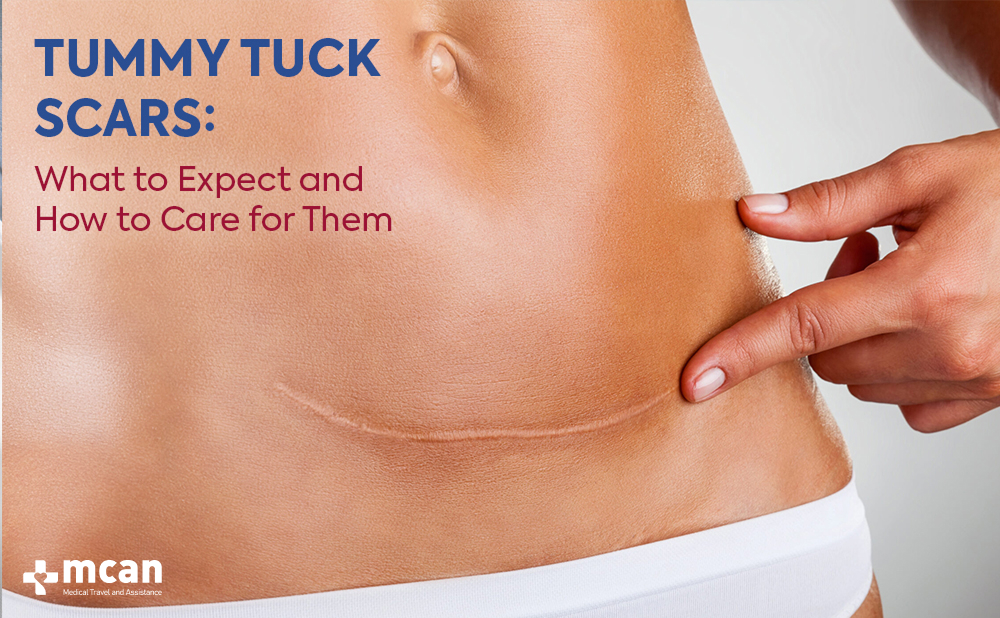
A tummy tuck can transform your abdominal contour, but it also leaves behind a scar that becomes part of your long-term result. For many patients, especially those preparing for surgery abroad, knowing what that scar will look like and how it will evolve over time is just as important as the aesthetic improvement itself.
Tummy tuck scars vary depending on the technique used, your skin type, and how your body heals. From the short incision of a mini tummy tuck to the more extensive lines of a 360 or Fleur-de-Lis abdominoplasty, each version comes with its own scar pattern, healing pace, and visibility.
In this guide, you’ll find detailed insight into how tummy tuck scars change over the months and years following surgery, what influences their appearance, and what you can actively do to support optimal healing. Whether you’re planning your procedure or already recovering, understanding scar behavior is the key to setting realistic expectations and getting the best possible long-term result.
What Is a Tummy Tuck Scar?
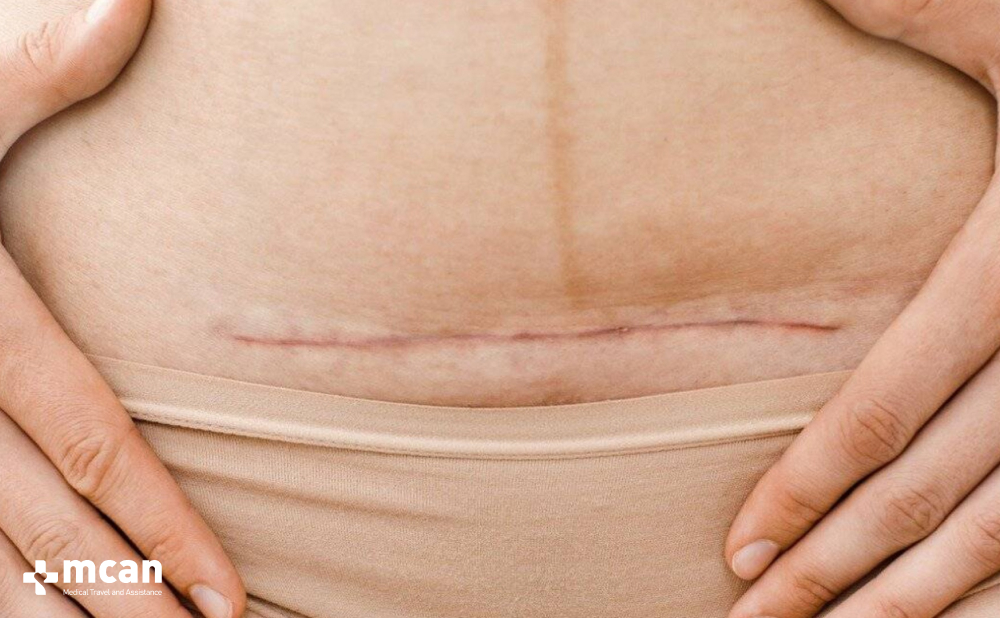
A tummy tuck scar is the physical result of the incision made during abdominoplasty surgery. The length and position of the scar depend on the type of tummy tuck performed, but in most cases, it’s placed horizontally across the lower abdomen, just above the pubic area, and designed to be concealed by underwear or swimwear.
The scar forms as part of the natural healing process. After the surgeon removes excess skin and fat and tightens the abdominal muscles, the skin is closed with sutures. As the skin knits together, the body produces collagen to seal the wound, which results in a visible line known as a scar.
There are multiple factors that influence how a tummy tuck scar will look, including:
- Skin thickness and elasticity
- Pigmentation and genetic tendency to form raised or dark scars
- How much tension was placed on the incision during closure
- Post-surgical care, including protection from sun and use of scar-reducing products

How Tummy Tuck Scars Change Over Time
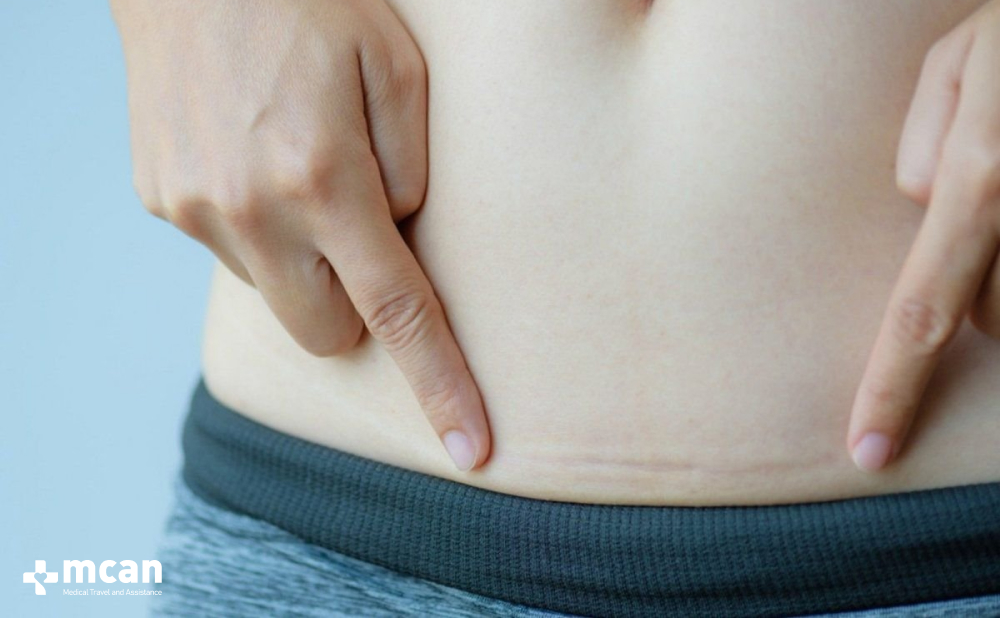
A tummy tuck scar doesn’t stay static, it changes noticeably as your body heals and remodels the incision site. Healing happens in phases, and while everyone’s experience is slightly different, the general timeline below gives a reliable sense of what to expect at each stage.
Tummy Tuck Scar After 6 Months
By the six-month mark, your scar is still in the remodeling phase. For many patients, this is when early signs of improvement start to become noticeable:
- The scar typically flattens slightly and may begin to lose some of its initial redness or pigmentation.
- It can still feel firm or slightly raised, especially in the center of the incision.
- Some areas may appear lighter than others due to uneven healing.
While the scar is still prominent, this stage often marks a turning point, your body has done most of the foundational repair, and now it focuses on refining the scar’s texture and tone.
Tummy Tuck Scar After 1 Year
At one year post-op, most tummy tuck scars have significantly softened and faded:
- The color usually changes from red or purple to light pink or pale beige, depending on your skin tone.
- The texture often becomes smoother, and tightness around the incision typically resolves.
- In well-healed cases, the scar is flat, soft to the touch, and blends with surrounding skin under clothing.
This is when patients begin to feel more confident in fitted clothing and swimwear. However, some individuals, especially those with darker skin tones or a genetic predisposition, may still see mild hyperpigmentation or thickness in parts of the scar.
Tummy Tuck Scar After 2 Years
After two years, the majority of tummy tuck scars reach full maturity:
- Scars are typically lighter, thinner, and more flexible.
- In many cases, the scar becomes barely noticeable unless closely examined.
- For those who followed a consistent aftercare routine, including sun protection and scar management products, the improvement is often more pronounced.
That said, some scars may remain slightly raised or darker if post-op care was inconsistent, or if the individual has a tendency toward hypertrophic or keloid scarring.
Tummy Tuck Scar After 3 Years
At the three-year point:
- The scar has likely stabilized in both color and texture.
- Ongoing improvement is still possible, especially with continued use of silicone-based gels or sheets, and regular moisturizing.
- If desired, non-surgical treatments like laser therapy, microneedling, or steroid injections may be considered to refine stubborn areas.
For most patients, this is when the scar becomes a faint line that is easily covered, even in minimal clothing.
Tummy Tuck Scar After 4 Years
After four years, a well-healed tummy tuck scar is typically:
- Fully integrated with surrounding skin
- Low in contrast, meaning it does not draw visual attention
- No longer changing in appearance without external treatment
At this stage, any remaining concerns are considered permanent unless addressed through aesthetic treatments.
Tummy Tuck Scar After 5 Years
By year five, the scar is considered fully mature and stable:
- For most, it’s a fine, pale line, often imperceptible in everyday scenarios.
- If any lingering thickness, redness, or irregularity remains, these may benefit from minor interventions.
It’s also worth noting that scar aging continues naturally. Like any other skin tissue, it can change slowly with aging and sun exposure. That’s why long-term scar care, including UV protection, still matters, even years after surgery.
Different Types of Tummy Tuck Scars
Not all tummy tucks leave the same kind of scar. The length, position, and visibility of the scar depend heavily on the type of abdominoplasty performed. Some patients only require minimal correction in the lower abdomen, while others need full or extended sculpting across the waistline and back. The approach your surgeon uses will shape both your result and the way the scar appears during recovery.
Here’s how the most common tummy tuck techniques compare in terms of scarring, coverage, and ideal use:
| Tummy Tuck Type | Scar Location | Visibility | Best For |
|---|---|---|---|
| Mini Tummy Tuck | Short horizontal incision just above the pubic area | Easily hidden in underwear and swimwear | Patients with minimal lower abdominal skin laxity |
| Full Tummy Tuck | Long horizontal incision from hip to hip, plus small scar around the navel | Visible but often concealed by clothing | Those needing full abdominal tightening, including muscle repair |
| Fleur-de-Lis (FDL) | Horizontal scar plus vertical incision up the midline (inverted T shape) | More extensive, but often hidden under clothing | Patients after massive weight loss with skin excess in multiple directions |
| Reverse Tummy Tuck | Incision under the breast crease (inframammary fold) | Very discreet, especially if combined with breast surgery | Those with loose skin in the upper abdomen |
| 360 Tummy Tuck | Circumferential incision around the lower torso | Most extensive scar, but offers full-body contouring | Post-bariatric patients or those with significant loose skin front, sides, and back |
For a comprehensive comparison between the Fleur-de-Lis and regular tummy tuck procedures, including insights into scarring and recovery, refer to our detailed article: Fleur de Lis Tummy Tuck vs. Regular Tummy Tuck: Which One Is Right for You?
How to Care for a Tummy Tuck Scar
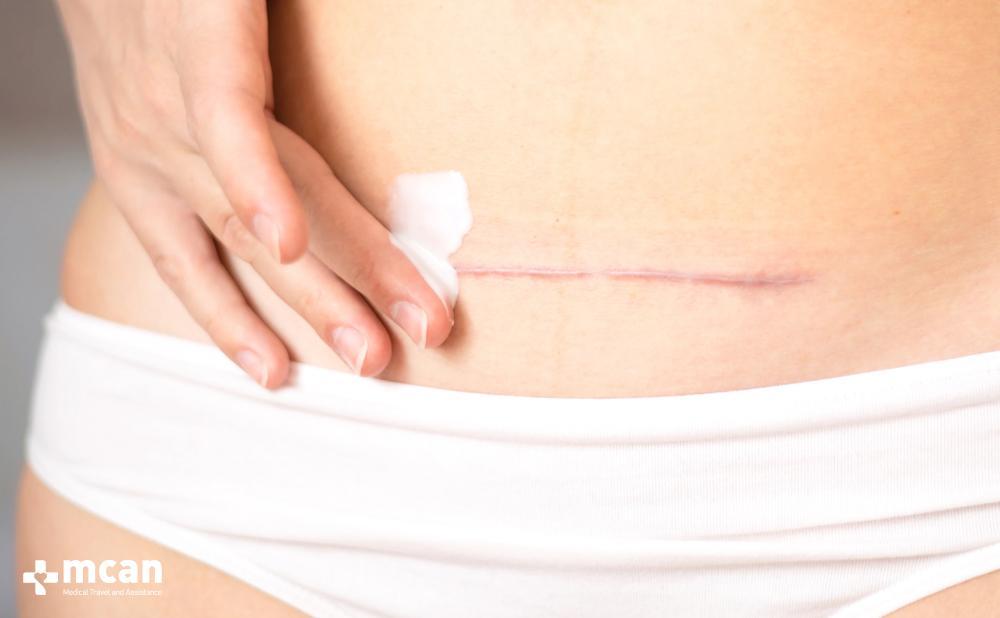
Proper care plays a major role in how a tummy tuck scar heals and fades over time. While surgical technique sets the foundation, your actions during recovery help determine whether a scar becomes flat and light or remains raised and noticeable.
Here are the most effective strategies to support scar healing and reduce long-term visibility:
1. Follow Your Surgeon’s Instructions Closely
The first few weeks after surgery are critical. Keep the incision clean and dry, avoid unnecessary movement, and wear your compression garment as advised. These steps reduce tension on the incision and help the scar form properly.
2. Protect the Area From Sun Exposure
UV rays can darken healing scars, especially in patients with pigmented skin. Always cover the area when outdoors, and once your surgeon approves, apply broad-spectrum sunscreen with SPF 30 or higher. This remains important even months after surgery.
3. Use Scar-Reducing Products
Once the incision has fully closed and your surgeon gives the go-ahead, consider products designed to improve scar appearance:
- Silicone sheets or gels: Clinically proven to reduce redness and flatten scars
- Hydrating ointments: Keep skin supple and prevent crusting or cracking
- Vitamin E and onion extract creams: These may help in some cases, but should be used cautiously and under medical guidance
4. Massage the Scar
Gentle scar massage, starting a few weeks post-op, can help break down internal scar tissue, soften the area, and improve blood flow. Use circular motions with a light moisturizer or silicone-based product. Always confirm the timing and technique with your surgeon.
5. Be Consistent and Patient
Scars evolve slowly. Even if initial healing goes well, it can take up to 18 months for the scar to fully mature. Avoid comparing progress with others and give your body the time it needs.
Can You Minimize Tummy Tuck Scars?
While some scarring is expected, there are ways to make scars less visible with the right care and planning:
- Choose the right technique: Mini tummy tucks leave smaller, lower scars compared to full or extended versions.
- Talk about incision placement: Surgeons usually place incisions low on the abdomen, hidden by underwear or swimwear.
- Avoid smoking and alcohol: Both reduce blood flow and increase risk of poor healing.
- Prevent infection and tension: Follow post-op instructions closely to avoid stretching the scar or causing irritation.
- Keep your skin healthy: Stay hydrated, eat well, and consider healing-supportive nutrients like zinc and vitamin C.
If you’re uncertain whether liposuction or a tummy tuck better suits your body goals and concerns about scarring, explore our guide: Liposuction or Tummy Tuck: How to Choose the Best Option for Your Body
Tummy Tuck in Turkey with MCAN Health
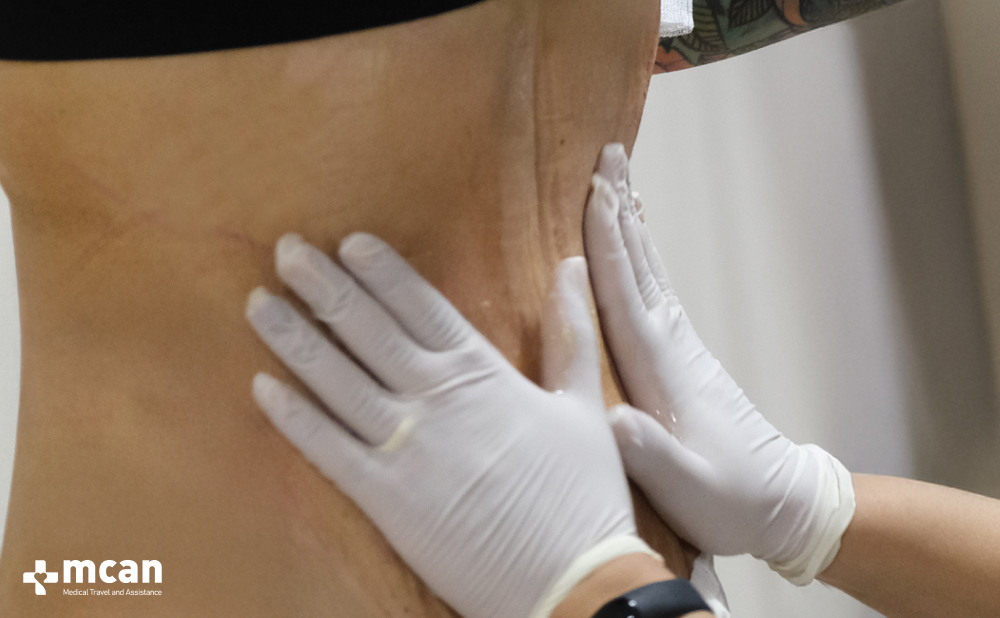
Tummy tuck scars are a natural part of the healing process, but with the right planning and care, they don’t have to define your results. At MCAN Health, we help patients achieve their ideal body contours while supporting every stage of healing, including scar management.
Here’s what we offer:
- All-inclusive tummy tuck packages covering surgery, accommodation, transfers, and nursing support
- Expert plastic surgeons experienced in both standard and specialized techniques like mini, FDL, and 360 tummy tucks
- TEMOS-accredited hospitals with advanced technologies for safety and precision
- Comprehensive aftercare, including hotel nurse visits, compression guidance, and scar care tips
- A UK-based follow-up office for patients who return home and want continued support
MCANCare™: Personalized Support from Start to Finish
Your tummy tuck experience doesn’t end when you leave the operating room. With MCANCare™, you receive continuous, personalized support designed to ease your recovery and enhance your results. This includes 24/7 medical assistance, hotel nurse visits, dressing changes, and guided follow-up, all coordinated by a dedicated team that speaks your language and understands your needs. From arrival to post-op recovery, MCANCare™ ensures you’re never alone in the process.
The video below highlights how MCANCare™ works in practice, showing the dedicated aftercare services that support patients every step of their tummy tuck journey.
Whether you’re considering tummy tuck in Turkey for aesthetic reasons or post-weight loss transformation, MCAN Health is here to guide you; safely, confidently, and with your comfort in mind.
Frequently Asked Questions About Tummy Tuck Scars
How long do tummy tuck scars take to fade?
Tummy tuck scars typically begin to fade noticeably after 6 to 12 months. Full maturation can take up to 2 years or more, depending on skin type, healing response, and scar care routines.
What do tummy tuck scars look like after 1 year?
After one year, most tummy tuck scars appear flatter and lighter in color. While some redness may persist, especially in fair or sensitive skin, the scar usually becomes easier to conceal beneath underwear or swimwear.
Will my tummy tuck scar be visible in a bikini?
Standard tummy tuck scars are usually placed low on the abdomen to sit below most bikini lines. However, visibility may vary slightly based on your individual anatomy and the type of swimwear you prefer.
Can tummy tuck scars become raised or keloid?
Yes, in patients who are prone to hypertrophic or keloid scarring, tummy tuck scars may become raised, thickened, or dark. Early intervention with silicone sheets, scar creams, and physician guidance can help minimize this risk.
Are there differences in scarring between mini and full tummy tucks?
Mini tummy tuck scars are typically shorter, as the procedure targets only the lower abdomen. Full or extended tummy tucks require a longer incision, which may result in a longer scar.
How can I improve the appearance of my tummy tuck scar?
Consistent aftercare is key. This includes using silicone-based products, keeping the area moisturized, avoiding sun exposure, and following your surgeon’s recommendations on activity restrictions and massage techniques.
Do reverse tummy tuck scars heal differently than traditional ones?
Reverse tummy tuck scars are placed under the breasts, which may be more visible depending on clothing and skin type. Their healing is similar, but they require careful support and protection due to movement in the upper torso.
Will my tummy tuck scar ever go away completely?
Tummy tuck scars do not fully disappear, but they typically become much less noticeable with time and proper care. In many patients, they fade into thin, pale lines that are easy to hide and forget.
Can laser treatment help with tummy tuck scars?
Yes, fractional laser treatments or microneedling can help improve scar texture and pigmentation if needed. These are usually considered a few months after surgery once the scar has matured.
What should I avoid if I want my tummy tuck scar to heal well?
To support optimal healing, avoid sun exposure, smoking, strenuous exercise too early, and picking or irritating the incision site. These can all worsen scar appearance and delay healing.
 Fleur de Lis Tummy Tuck vs. Regular Tummy Tuck: Which One Is Right for You?
Fleur de Lis Tummy Tuck vs. Regular Tummy Tuck: Which One Is Right for You?  MCAN Health Received Accreditation from TEMOS International Once Again!
MCAN Health Received Accreditation from TEMOS International Once Again!